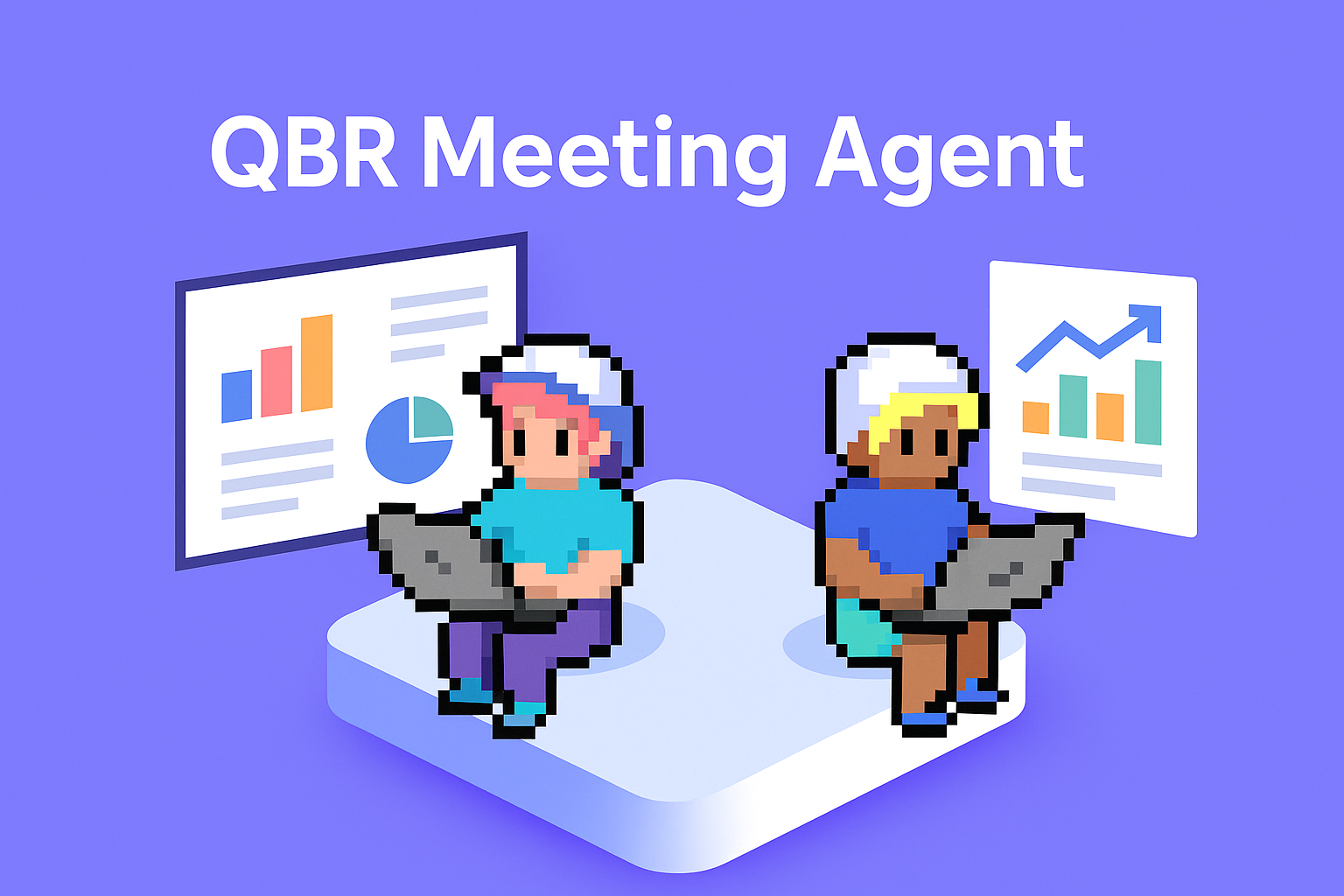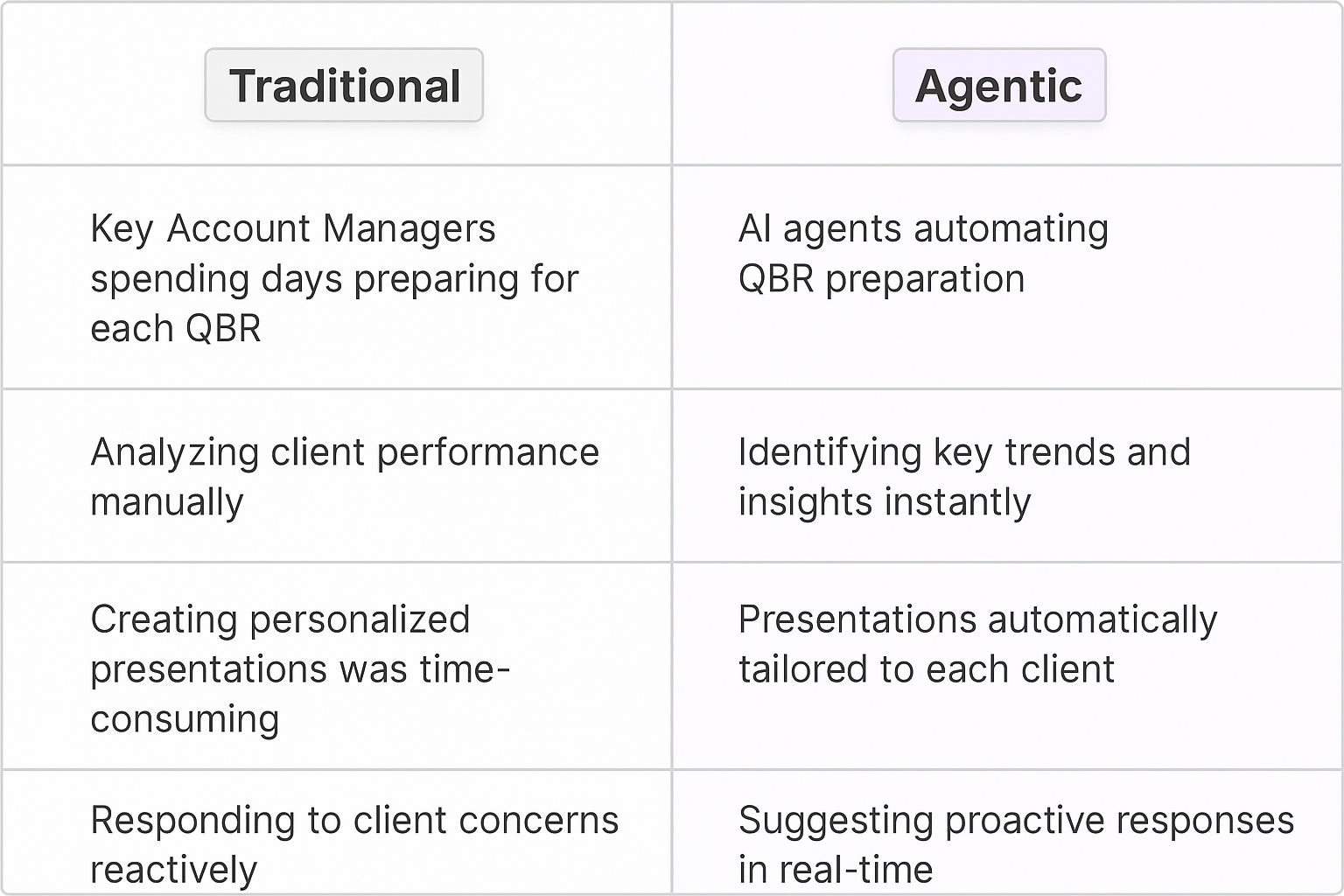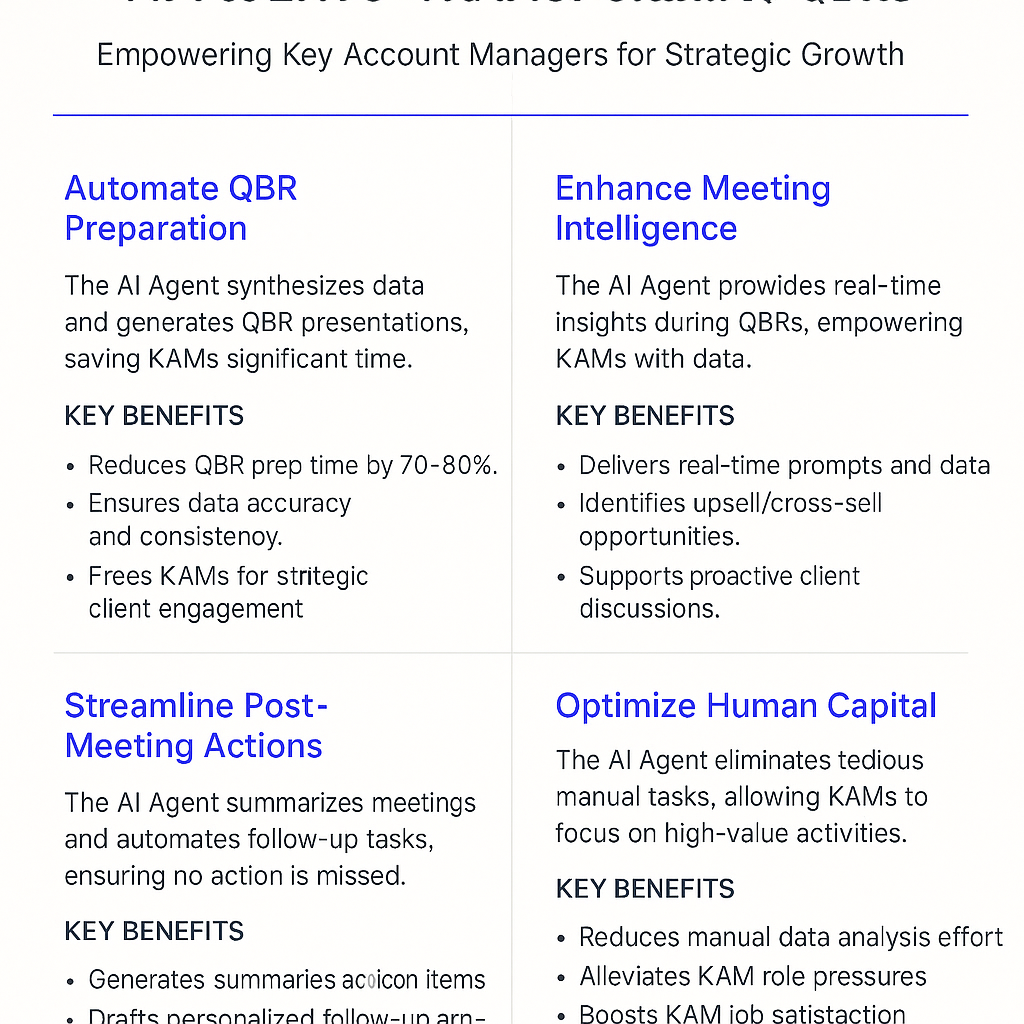
AI-powered meeting planner agents are revolutionizing how Key Account Managers conduct Quarterly Business Reviews (QBRs). These agents automate the tedious aspects of QBR preparation, from data analysis to presentation creation, allowing managers to focus on building strong client relationships and driving business growth. This technology streamlines workflows, enhances meeting effectiveness, and improves overall client satisfaction.
Before Meeting
Your AI agent analyzes client data, identifies trends, and generates performance reports ahead of time. You walk into the meeting with a clear understanding of the client's performance and potential opportunities.
During Meeting
As the meeting progresses, your AI agent provides real-time insights, suggests responses to client concerns, and identifies upselling or cross-selling opportunities based on the client's business patterns.
After Meeting
Post-meeting, your AI agent summarizes key discussion points, tracks action items, and sends follow-up emails. This ensures accountability and keeps the client relationship moving forward.
What you’ll need
You don't need to be a developer to set up this integration. Follow this simple guide to get started:
- Meeting Notetaker Agent template
- Calendar account
- Meetings to join
- Relevance AI Account

Who this agent is for
This agent is designed for Key Account Managers, Client Success Managers, Sales Directors, and anyone responsible for conducting Quarterly Business Reviews (QBRs) with key clients. It's ideal for individuals and teams who need to analyze client performance data, identify trends and opportunities, and create compelling presentations to showcase value and drive client retention. Whether you're managing a portfolio of strategic accounts or leading a team of account managers, this agent simplifies QBR preparation and ensures you're always prepared to deliver impactful client reviews.
How this agent makes QBR planning easier
Automate data analysis and reporting
Instead of manually compiling data from various sources, the agent automatically analyzes client performance data, identifies key trends, and generates comprehensive reports. This saves significant time and reduces the risk of errors.
Create personalized presentations
The agent automatically creates personalized presentation materials based on the client's specific performance data and strategic objectives. This ensures that each QBR is tailored to the client's needs and interests.
Provide real-time insights during meetings
During the QBR, the agent provides real-time insights, suggests responses to client concerns, and identifies upselling or cross-selling opportunities based on the client's business patterns.
Streamline follow-up actions
After the QBR, the agent summarizes key discussion points, tracks action items, and sends follow-up emails. This ensures accountability and keeps the client relationship moving forward.
Benefits of AI Agents for Key Account Managers
What would have been used before AI Agents?
Key Account Managers traditionally relied on manual data analysis, spreadsheet-based reporting, and generic presentation templates to prepare for QBRs. This process was time-consuming, prone to errors, and often resulted in inconsistent or uninspired client reviews. They would spend valuable time gathering data, creating charts, and customizing presentations, taking away from their core responsibilities of building client relationships and driving business growth.
What are the benefits of AI Agents?
AI agents offer a streamlined and automated approach to QBR preparation, freeing up Key Account Managers to focus on more strategic tasks. The most significant benefit is the time saved by automating data analysis and report generation. The agent handles everything from data collection to presentation creation, reducing the administrative burden on the manager.
AI agents also improve the quality and consistency of QBRs by providing accurate and personalized insights. This ensures that each client review is tailored to the client's specific needs and interests. Furthermore, the agent enhances communication by providing real-time insights and suggesting responses to client concerns.
By integrating with existing CRM systems and data sources, the agent provides a seamless and user-friendly experience. This eliminates the need for manual data entry and ensures that all QBR-related information is easily accessible. Ultimately, AI agents enhance productivity, reduce stress, and allow Key Account Managers to focus on building strong client relationships and driving business results.
Traditional vs Agentic meeting planning
Traditionally, Key Account Managers spent days preparing for each QBR, manually compiling data and creating presentations. Now, AI agents automate this, freeing up time for strategic client engagement. Before, analyzing client performance involved sifting through multiple spreadsheets and reports. With an agent, key trends and insights are identified instantly. Creating presentations used to be a time-consuming task. Now, they're generated automatically, tailored to each client's needs. Responding to client concerns during the meeting was often reactive. The agent suggests proactive responses based on real-time data. Finally, tracking action items and sending follow-up emails were manual tasks, often delayed. The agent automates this, ensuring accountability and timely communication.

Tasks that can be completed by a Meeting Planner Agent
Key Account Managers juggle numerous tasks, from managing client relationships to developing strategic account plans and driving revenue growth. A meeting planner agent can handle many of the administrative tasks associated with preparing for and conducting QBRs, allowing managers to focus on their core responsibilities.
Analyzing Client Performance Data
The agent analyzes client performance data from various sources, including CRM systems, financial reports, and usage analytics, to identify key trends and opportunities.
Generating Performance Reports
The agent automatically generates performance reports that summarize the client's key metrics and highlight areas for improvement.
Creating Personalized Presentations
The agent creates personalized presentation materials based on the client's specific performance data and strategic objectives.
Providing Real-Time Insights During Meetings
The agent provides real-time insights, suggests responses to client concerns, and identifies upselling or cross-selling opportunities based on the client's business patterns.
Tracking Action Items and Follow-Up Tasks
The agent tracks action items and follow-up tasks from the QBR and sends reminders to ensure that they are completed on time.
Integrating with CRM Systems and Data Sources
The agent integrates with CRM systems and other data sources to ensure that all QBR-related information is easily accessible.
Scheduling and Coordinating QBR Meetings
The agent can schedule and coordinate QBR meetings, sending invitations and reminders to all participants.

Things to Keep in Mind When Building a Meeting Planner Agent
Building an effective meeting planner agent requires careful planning and attention to detail. The goal is to create an agent that seamlessly integrates with your existing workflows and provides a user-friendly experience for all participants.
Define Clear Objectives
Before you start building your agent, define clear objectives for what you want it to achieve. Do you want to reduce QBR preparation time, improve the quality of client reviews, enhance communication, or all of the above? Having clear objectives will help you prioritize features and measure success.
Integrate with Existing Systems and Data Sources
Ensure that your agent integrates seamlessly with your CRM system, financial reports, and other data sources. This will make it easier to access and analyze client performance data.
Prioritize User Experience
Make sure that the agent is easy to use and intuitive. The interface should be clean and uncluttered, and the QBR preparation process should be straightforward and efficient.
Automate Data Analysis and Reporting
Configure the agent to automate data analysis and generate comprehensive reports. This will save significant time and reduce the risk of errors.
Provide Customizable Templates and Presentations
Allow users to customize the agent's templates and presentations to match their branding and style. This will ensure that each QBR is consistent and professional.
Test Thoroughly
Before you roll out the agent to your entire team, test it thoroughly to ensure that it is working correctly and that it meets your objectives. Gather feedback from users and make any necessary adjustments.
Continuously Improve
Once your agent is live, continue to monitor its performance and gather feedback from users. Use this information to identify areas for improvement and make ongoing enhancements.
The Future of AI Agents in Meeting Planning
The future of AI agents in meeting planning is bright, with advancements in natural language processing, machine learning, and artificial intelligence promising to further streamline and enhance the QBR process. Future agents will be able to understand complex client requests, anticipate potential concerns, and proactively suggest solutions.
AI agents will also become more personalized, learning individual preferences and tailoring their recommendations accordingly. They will be able to identify preferred presentation styles, communication approaches, and even preferred topics of discussion, creating a more seamless and engaging QBR experience.
Furthermore, AI agents will play a larger role in facilitating collaboration and communication during QBRs. They will be able to transcribe meeting minutes, track action items, and even provide real-time translation services, making QBRs more productive and inclusive.
AI agents will also integrate with other business applications, such as project management tools and marketing automation platforms, providing a holistic view of client-related activities and enabling better decision-making.
Ultimately, the future of AI agents in meeting planning is about creating intelligent systems that not only automate the QBR process but also enhance client relationships, improve communication, and track action items to drive better business outcomes.









